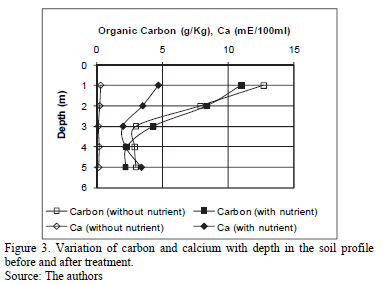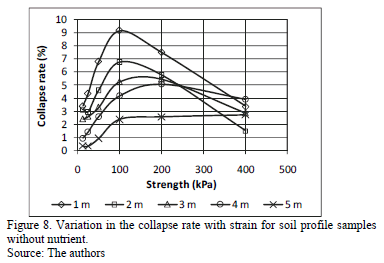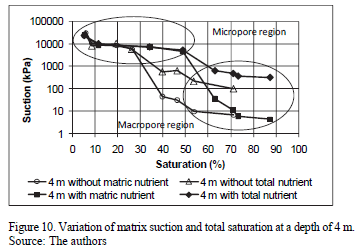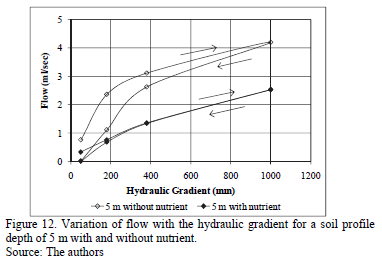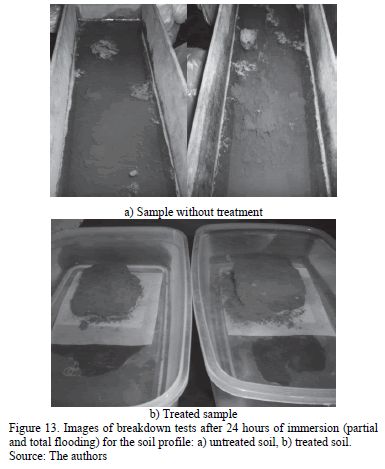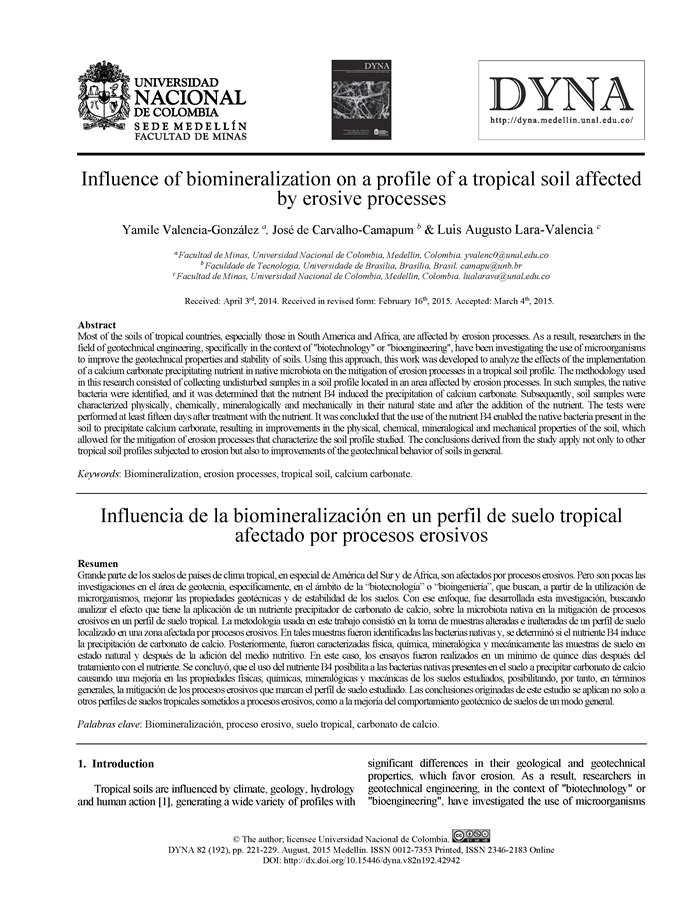
Publicado
Influence of biomineralization on a profile of a tropical soil affected by erosive processes
DOI:
https://doi.org/10.15446/dyna.v82n192.42942Palabras clave:
Biomineralization, erosion processes, tropical soil, calcium carbonate. (es)Descargas
DOI: https://doi.org/10.15446/dyna.v82n192.42942
Influence of biomineralization on a profile of a tropical soil affected by erosive processes
Influencia de la biomineralización en un perfil de suelo tropical afectado por procesos erosivos
Yamile Valencia-González a, José de Carvalho-Camapum b & Luis Augusto Lara-Valencia c
a Facultad de Minas, Universidad Nacional de Colombia, Medellín, Colombia. yvalenc0@unal.edu.co
b Faculdade
de Tecnologia, Universidade de Brasília, Brasília, Brasil. camapu@unb.br
c Facultad de Minas, Universidad Nacional de Colombia, Medellín, Colombia. lualarava@unal.edu.co
Received: April 3rd, 2014. Received in revised form: February 16th, 2015. Accepted: March 4th, 2015.
This work is licensed under a Creative Commons Attribution-NonCommercial-NoDerivatives 4.0 International License.

Abstract
Most of the soils of
tropical countries, especially those in South America and Africa, are affected
by erosion processes. As a result, researchers in the field of geotechnical
engineering, specifically in the context of "biotechnology" or
"bioengineering", have been investigating the use of microorganisms
to improve the geotechnical properties and stability of soils. Using this
approach, this work was developed to analyze the effects of the implementation
of a calcium carbonate precipitating nutrient in native microbiota on the
mitigation of erosion processes in a tropical soil profile. The methodology
used in this research consisted of collecting undisturbed samples in a soil
profile located in an area affected by erosion processes. In such samples, the
native bacteria were identified, and it was determined that the nutrient B4
induced the precipitation of calcium carbonate. Subsequently, soil samples were
characterized physically, chemically, mineralogically and mechanically in their
natural state and after the addition of the nutrient. The tests were performed
at least fifteen days after treatment with the nutrient. It was concluded that
the use of the nutrient B4 enabled the native bacteria present in the soil to
precipitate calcium carbonate, resulting in improvements in the physical,
chemical, mineralogical and mechanical properties of the soil, which allowed
for the mitigation of erosion processes that characterize the soil profile
studied. The conclusions derived from the study apply not only to other
tropical soil profiles subjected to erosion but also to improvements of the
geotechnical behavior of soils in general.
Keywords: Biomineralization, erosion processes, tropical soil, calcium carbonate.
Resumen
Grande
parte de los suelos de países de clima tropical, en especial de América del Sur
y de África, son afectados por procesos erosivos. Pero son pocas las
investigaciones en el área de geotecnia, específicamente, en el ámbito de la
"biotecnología" o "bioingeniería", que buscan, a partir de la utilización de
microrganismos, mejorar las propiedades geotécnicas y de estabilidad de los
suelos. Con ese enfoque, fue desarrollada esta investigación, buscando analizar
el efecto que tiene la aplicación de un nutriente precipitador de carbonato de
calcio, sobre la microbiota nativa en la mitigación de procesos erosivos en un
perfil de suelo tropical. La metodología usada en este trabajo consistió en la
toma de muestras alteradas e inalteradas de un perfil de suelo localizado en
una zona afectada por procesos erosivos. En tales muestras fueron identificadas
las bacterias nativas y, se determinó si el nutriente B4 induce la
precipitación de carbonato de calcio. Posteriormente, fueron caracterizadas
física, química, mineralógica y mecánicamente las muestras de suelo en estado
natural y después de la adición del medio nutritivo. En este caso, los ensayos fueron realizados en un
mínimo de quince días después del tratamiento con el nutriente. Se concluyó,
que el uso del nutriente B4 posibilita a las bacterias nativas presentes en el
suelo a precipitar carbonato de calcio causando una mejoría en las propiedades
físicas, químicas, mineralógicas y mecánicas de los suelos estudiados,
posibilitando, por tanto, en términos generales, la mitigación de los procesos
erosivos que marcan el perfil de suelo estudiado. Las conclusiones originadas
de este estudio se aplican no solo a otros perfiles de suelos tropicales
sometidos a procesos erosivos, como a la mejoría del comportamiento geotécnico
de suelos de un modo general.
Palabras clave: Biomineralización, proceso erosivo, suelo tropical, carbonato de calcio.
1. Introduction
Tropical soils are influenced by climate, geology, hydrology and human action [1], generating a wide variety of profiles with significant differences in their geological and geotechnical properties, which favor erosion. As a result, researchers in geotechnical engineering, in the context of "biotechnology" or "bioengineering", have investigated the use of microorganisms in improving the geotechnical properties and stability of soils. Most studies in biotechnology have been directed toward understanding the behavior of bacteria, their interaction with many of the minerals found in nature or their application in the decontamination of soils and water resources and the restoration of sculptures [2]. However, in general, there have been few studies focused on the influence of bacteria on soil behavior and engineering properties [3]. In this study, we applied knowledge acquired in other areas related to bacteria to provide solutions to engineering problems using the technique of biomineralization. This technique consists of stimulating microorganisms using a nutrient to precipitate chemical compounds, thus forming minerals. In the present study, the precipitation of calcium carbonate by native bacteria in the soil, aimed to improve the physical properties, mechanical parameters and structural stability of soil against erosion processes, was examined. This study represents an advance in the development of biotechnology applications to solving engineering problems, specifically those of erosion, resulting in a significant economic and environmental impact. In most cases, to prevent, stop or restore areas affected by erosion, controls are used, which often have high costs and/or have an environmental impact that is not always negligible in other areas.
2. Soil microbiology
Research with microorganisms began in 1673 with Van Leeuwenheek but, according [4], only gained momentum in 1857 with the studies of Louis Pasteur. However, soil microbiology had its first major contribution in the late nineteenth century, with the isolation of rhizobia.
The study of soil microbes is vast and unknown as soil is an unusual habitat in relation to other terrestrial habitats, due to its heterogeneous, complex and dynamic nature. Within this complex habitat, five main groups of microorganisms exist: bacteria, actinomycetes, fungi, algae and protozoa. The bacteria are notable because they form the group of microorganisms of greatest abundance and diversity among species. The bacterial community is estimated at approximately 108 to 109 (CFU) per gram of soil [5].
Many variables influence soil bacteria, such as moisture, aeration, temperature, organic matter, acidity and the presence of inorganic nutrients. Other variables, such as crops, the season and depth, have relevance, yet their combination makes them determinant [6].
The activity that microorganisms play in the soil may be closely related to the soil structure. Due to the similar size of microorganisms and soil components, particularly bacterial cells and clay particles, there is the possibility of accession or linking of microbial cells to clay particles. The nature of this adhesion is mainly chemical and mediated by cement substances. The rate of adherence of microorganisms to soil mineral particles is often quite considerable and may reach 90% of the population. This adhesion depends on the diameter of the particles: the smaller the diameter, the stronger the adhesion. Adhesion also depends on the nature of the microorganism and the type of clay mineral. For example, Gram-positive bacteria more easily adhere to clay minerals, such as kaolinite, which have predominantly negative surface charges, because Gram-negative bacteria are fixed on positively charged minerals, such as gibbsite [5].
3. Biomineralization
Biomineralization is a common process in nature by which living organisms form precipitated crystalline or amorphous minerals [7]. Biomineralization occurs through chemical reactions between specific ions or compounds as a result of metabolic activities of an organism under certain environmental conditions. The "carbonate-geneses" is a good example of biomineralization, in which it precipitates carbonates [8].
Photosynthesis is the most common form of carbonate microbial precipitation [9]. This process is based on the metabolic utilization of dissolved CO2, which equilibrates with HCO and CO (eq. 1) around the bacterium. This reaction induces a shift in the balance of bicarbonate and, subsequently, an increase in the pH in most of media (eq. 2 and 3).

Another type of process that precipitates carbonates is the sulfur cycle, specifically the reduction of sulfate. The reaction begins with the dissolution of gypsum (CaSO4.2H2O/CaSO4, eq. 4). In these circumstances, the organic matter can be consumed by sulfate-reducing bacteria, and sulphide and metabolic CO2 is released (eq. 5).

The removal of sulfur produced from hydrogen (H2S) and the result of the increase in pH are prerequisite to the precipitation of carbonates [10].
Another form of precipitation involves the nitrogen cycle and, more specifically, the ammonification of amino acids, nitrate reduction and degradation of urea [11]. These three mechanisms have in common the production of metabolic CO2 and ammonia (NH3), which, in the presence of calcium ions, results in precipitation of ammonium ions and the release of carbonate. The reaction takes place according to eq. 6 and 7:

In complex natural environments, different metabolisms can combine to produce precipitation.
Under such conditions, precipitation of calcium carbonate (CaCO3) can occur from the equilibrium reaction shown in eq. 8 if soluble calcium ions (Ca+2) are present.

It is noteworthy that the production of CO3-2 from bicarbonate (HCO3-1) in water is highly dependent on pH and that growth occurs under alkaline conditions. In summary, the precipitation of calcium carbonate occurs easily in alkaline environments abundant in calcium (Ca2 +) and carbonate ions (CO3-2) [8].
The main role of bacteria in the process has been linked to their ability to create alkaline environments and to increase the concentration dissolved inorganic carbon (DIC) through various physiological activities [9].
Specific species of bacteria are capable of producing different amounts, forms and types of crystals of carbonate (e.g., calcite, aragonite and dolomite) from the same synthetic medium [9].
The study of the bioprecipitation process by microorganisms, especially of calcium carbonate, began at the end of the nineteenth century by Nadson (1899-1903). Several genera and species of bacteria were isolated from the environment and systematically studied, contributing to our knowledge of the bioprecipitation processes in the production of calcium carbonate.
The research conducted in [8] and [12] showed that bacteria such as Bacillus have the ability to precipitate CaCO3 when incubated in B4, which is a nutrient composed of yeast extract, glucose and calcium acetate, at a pH of 8 and incubation temperatures of 25 to 30°C. The precipitation begins to occur after 15 days. Upon observation of the precipitates for 25 days, the number and size of crystals were found to increase with time.
The first study of the applicability of the process of calcium carbonate bioprecipitation, called "bioremediation", was based on protection against deterioration of materials used in construction, such as ornamental stones and concrete, using a nutrient medium containing bacteria [8]. Subsequent techniques, such as "bio-induration" or "bio-sealing", have consisted of sealing or plugging the pores of the soil through the application of nutrients and microorganisms capable of producing a biofilm, which were used to reduce the permeability of soils [13,14]. Finally, the technique of "biostabilization" improves soil properties through the addition of microorganisms and nutrients [15].
In this study, instead of adding microorganisms to the material as has been done previously, we stimulate the native microorganisms present in the tropical soil to precipitate calcium carbonate minerals from the addition of only one nutrient. This technique has a reduced environmental impact as compared to other techniques commonly used to prevent, halt or reclaim areas affected by erosion.
4. Materials and methods
The search region was in a location affected by erosion, specifically, in the gullies. The selected profile was located 20 m from the left edge of a gully in the town of Santa Maria, Brasília, Federal District - Brazil.
The study was limited to 6 m deep, with profiles of five soil layers: 0 to 1.5 m, 1.5 m to 2.5 m, 2.5 m to 3.5 m, 3.5 m to 4.5 m and 4.5 m to 6.0 m. According to [1], this profile is located in the geological unit "Sandy Metarritmito" from the Paranoá group. The "Sandy Metarritmito" is composed of fine to medium interbedded quartzite, siltstones and slates. The maximum thickness of this structure can reach 150 m [16]. The gully geomorphologically lies within the "Contagem Plateau". This plateau is the highest in the Federal District with an average elevation of more than 1200 m. The area has a climate with temperatures below 18°C in the coldest month and greater than 22°C in the warmest month. The average annual relative humidity is 60%.
4.1. Microbiological analyses
For the microbiological identification of bacteria present in the soil profile, first, a 10 g sample of each layer was taken and placed in a plastic sterile container with 90 mL of peptone water to make a 1:10 dilution. Then, from this mixture, 1 ml was taken and homogenized with 9 ml of 0.1% buffered water to obtain a dilution of 1:100. Each dilution was incubated in a bacteriological incubator under 25°C for 24 hours and distributed to the respective dilutions, in the form of stripes with a platinum handle on plates containing agar and 5% sheep blood, for the growth and isolation of the bacterial population.
The identification of bacterial colonies was carried out through various biochemical tests: GRAM test, 3% KOH test, catalase test, oxidase test, TSI test, oxidation/fermentation test, indole test, urease test, mannitol fermentation, nitrate reduction test, production of desidrolase and decarboxylases of amino acids, gelatin hydrolysis test, Methyl Red test, Voges-Proskauer test, utilization of citrate, motility test, fermentation of lactose, sucrose, glucose, maltose, arabinose and trehalose and hydrolysis of Esculin.
After the bacteria in the soil were identified, the samples were placed on plates containing the nutrient medium B4, which induces the precipitation of calcium carbonate. The medium components were 15 g calcium acetate, 4 g stratum yeast, 5 g glucose and 12 g agar in 1 L of distilled water. In order for the bacteria to promote the precipitation of calcium carbonate, it was important to maintain the pH at about 8. To achieve this pH, NaOH was incorporated into the described solution [8]. The plates with the bacteria in B4 medium were incubated for at least 15 days at 25°C [12].
The precipitates were observed using a scanning electron microscope (SEM) to determine whether they contained the calcium element. After verification of the mechanism of precipitation from the bacteria found in soil, the nutrient was added to blocks of undisturbed soil, for the precipitation to occur in locus.
The blocks of undisturbed soil from each layer were placed inside a container, which, at the time of the nutrient addition, did not crumble. At the top of the blocks, holes were made, about 0.4 cm in diameter and 2 cm deep with a 10 cm spacing. The nutrient was introduced in the holes with the use of a syringe. The nutrient filled 60% of the empty spaces present in each block of undisturbed soil. Subsequently, the blocks were kept for a minimum of 15 days within a "moisture chamber" (25°C and relative humidity 60%), similar to the average conditions of the erosion site selected for the study.
The influence of the treatment on the properties of the soil was evidenced by running physical, chemical, mineralogical and mechanical sample tests with and without the addition of the nutrient. These tests were performed according to the methodologies proposed by the Brazilian Association of Technical Standards (ABNT) and in their absence, according to the American Standard Test Method (ASTM).
4.2. Physical properties
For the physical characterization of the soil profile, tests were carried out to determine the moisture, specific weight of grains, Atterberg limits and grain size with and without dispersant, and tests MCT (Miniature Compressed Tropical) of tropical soils expedite classification [17]. Voids and the degree of saturation were determined from the soil samples.
4.3. Chemical analyses
These tests consisted of measurements of the pH in water and KCl solution at a ratio of 10:25 (soil: water/solution) and determining levels of calcium (Ca), sodium (Na), potassium (K), magnesium (Mg), H + Al (total acidity), organic matter (OM), organic carbon (C), nitrogen (N), phosphorus (P) and sulfur (S), as well as the cation exchange capacity (CEC), base saturation and aluminum saturation. These tests were performed according to EMBRAPA standards [18].
4.4. Mineralogical analyses
The mineralogical characterization was limited to the identification of minerals in layers of soil profiled by X-ray diffraction, complemented with semi-qualitative chemical analysis obtained by energy dispersive spectroscopy (EDS) using SEM.
4.5. Structure definition
Deeply weathered tropical soils, such as those used in this study, cannot be thought of as individual soil particles because the particles are grouped together, forming aggregates that directly influence the physical properties and mechanical and hydraulic behavior of the soil. However, the chemical additives can affect the structural stability of these aggregates, but the biomineralization may give them greater stability providing structural changes in the ground. The structural changes caused by biomineralization may explain certain behavior in soil.
Structural characterization of the soil was made from the visual analysis of images obtained from SEM.
4.6. Mechanical behavior
Analyzing the mechanical behavior of soils is very important in defining the influence of biomineralization in the erosion stabilization of slopes. For its determination, the following parameters were determined: compressive strength, indirect tensile strength, resistance to direct shear, total matrix suction, dual-oedometer densification and permeability. Tests were also conducted to estimate the susceptibility to erosion, such as the pinhole test and the test of disaggregation.
5. Results
5.1. Microbiological characterization
From different biochemical tests of the entire profile, a total of 43 types of isolated bacteria were identified: among them were Bacillus spp., Pasteurella spp., Actinobacillus spp., Pseudomonas spp., Staphylococcus spp., Alcaligenes spp., Rhodococus spp., Corynebacterium spp., Rhodococus quei, Francisella tularensis and Enterobacter cloacae; with the Bacillus spp. as the most common bacteria.
In the microbiological analysis, it was found that the amount of bacteria present increased with depth. This may be linked to increases in water pH with the depth of soil (1 m: 5.6, 2 m: 5.8, 3 m: 5.9, 4 m: 6.1 and 5 m: 5.9). According to [19], the environment most favored by bacteria is one in which the pH is close to 8.
The precipitation occurred in Petri dishes containing the B4 medium. Then, the samples coated with gold were pasted onto a sample holder (hence the presence of the gold peak in the determined chemical composition), and observed by SEM, which confirmed the presence of calcium in all of the samples (black spot in Fig. 1).
Importantly, when Bacillus was present, the greatest precipitation of calcium was generated (larger precipitates in the Petri dishes), which confirms that Bacillus-type bacteria are excellent for the process of biomineralization [12].
5.2. Physical characterization
The results of physical characterization tests for the five layers of natural soil profiles are presented in Table 1, together with the results obtained for the soil treated with the B4 nutrient, which allows for an evaluation of the influence of the addition of B4 to the medium on the physical properties after a minimum of 15 days.
The results in Table 1 show that the void index decreased slightly with the addition of nutrients because the precipitates formed with little intensity or very fine fibers.
To evaluate the stability of micro-concretions that were present in the soil profile, the expression given by [20] for the total aggregate (TA = % clay size with dispersant - % clay size without dispersant) was used. When the nutrient was used, the TA values were lower, indicating greater stability of the micro-concretions.
Using the liquidity limit (wL) and plasticity index (Ip), it was observed that the plasticity of a clay, in general, may decrease as the number of cations and calcium increases [21]. In addition, the treatment helped to maintain soil aggregation by making it more granular, which generally favors the reduction of plasticity.
The treatment gave stability to the aggregates, which according to the MCT system, classifies the soil as sand. However, based on the USCS, due to the reduced plasticity, the soil is classified as having low plasticity. The fact that no changes were observed in the classification of any of the layers does not necessarily mean that the treatment did not influence the behavior of the soil. However, it indicates a low sensitivity of classification methods to assess levels of change experienced by the soil.
5.3. Chemical characterization
Fig. 2 shows that, by adding the nutrient to the samples, the pH increased from slightly acidic to slightly basic, with basic being greater than pH 7 in water. An alkaline pH is needed to generate an environment favorable for bacteria to precipitate calcium carbonate [22].
The generation of calcium carbonate is contingent on the existence of carbon and calcium, hence the importance of the relationship that exists between the organic carbon content and calcium content (Fig. 3). Samples with nutrient, at depths less than 3 m, showed a reduction in the amounts of calcium and carbon, with a higher rate of reduction of carbon than of calcium. Beyond 3 m, the reduction of carbon continued, but the calcium increased and in larger quantities than carbon, implying that not all of the calcium forms calcite at these depths and that part of the calcium must be available associated with minerals or as chemical complexes. Moreover, in the first 3 m, there was a surplus of carbon, meaning that there may be more additions of calcium because the relationship of these elements in calcite is 1:1.
5.4. Mineralogical characterization
Figs. 4 and 5 show that the original minerals were preserved when comparing the samples without nutrient to samples with nutrient, i.e., the treatment does not affect the initial mineralogical composition. There is, however, in Fig. 5, the appearance of mineral calcium carbonate (calcite, 1 m, 2 m, 4 m and 5 m and wilkeita at 3 m), thus confirming, even in small amounts, the precipitation generated by bacterial activity with the treatment.
It should be noted that the amount of kaolinite present in the soil was related to the adherence of Gram-positive bacteria, which, in the presence of nutrient, present precipitation of calcium carbonate as already shown in the initial studies for the bacterial characterization on Petri dishes.
To confirm the formation of calcium carbonate, hydrochloric acid (HCl) was poured on the soil samples with and without nutrient. All treated soil samples showed effervescence, confirming the presence of carbonates.
5.5. Structure characterization
When the nutrient was not added to the chemical analysis, the SEM images illustrated common elements of tropical soils (Fig. 6). In soils with the nutrient, the presence of fibrous precipitates containing calcium that bind soil grains or crystals of different fibers, called "globular or botryoidal habit" (Fig. 7), were observed at all depths.
5.6 Mechanical characterization
5.6.1. Direct shear strength of saturated and natural soil
To analyze the influence of nutrient addition on the shear strength, the parameters of cohesion and friction angle in isolated form were examined (Table 2).
In almost all cases, the friction angles and cohesion in natural and immersed states increased when passing from untreated soil to treated soil, which confirms that the generated precipitate acted as cement for the soil profile studied. The increase of friction angles and cohesion from the treatment was reflected in the increase in shear strength.
The resistance increases to the depths of 1m and 2m were the lowest. This may be related to the fact that at these depths the initial moisture content of the samples was the highest, or may also be due to the fact that at these depths the amount of kaolinite is less, resulting in a lower adhesion of Gram-positive bacteria type Bacillus spp., and consequently, causing a smaller amount of precipitates [22].
5.6.2. Dual-oedometer density
Soil samples were assayed in their natural state and in a saturated state to determine the structural collapse inundation (Collapse rate %). There is a clear reduction in the collapse potential of the treated soils (Fig. 9) as compared to those obtained at the same depths for the untreated soils (Fig. 8).
5.6.3. Total suction and matrix suction
Fig. 10 shows a plot for the soil layer at a depth of 4 m as an example of the general behavior of the total and matrix suction observed for all of the layers. The treatment increased the total suction in the macropore region. Despite the difficulty that arises in identifying a unique behavior and
the influence of treatment on the behavior for the matrix suction, it is worth noting the shift to the right of the point of entry of air in the micropores registered for the curves depending on the degree of saturation during the treatment. This shift indicates a reduction in macroporosity.
5.6.4. Permeability
By examining the permeability as a function of the inter-aggregated void ratio of soil, which represents voids in which water circulates and the carbonates precipitated, at all depths, it was found that the nutrient caused a decrease in permeability (Fig. 11).
5.6.5. Pinhole test
Fig. 12 presents the behavior before the internal erosion of the soil layer at a depth of 5 m. For all depths, the treatment indicated a greater closure of the pores due to the precipitation of calcium carbonate and greater structural stability as the curves obtained with treatment were quasi-linear, with little difference between the phases of loading (→) and unloading (←) and the outflows for the same gradients were lower than in the untreated soil.
5.6.6. Breakdown
The results of the breakdown test clearly illustrated the improvement of the structural stability of the soils when partially or totally inundated with water. Little or no breakdown was observed for the treated soils immersed in water. Fig. 13 shows the sample images to a depth of 3 m with and without treatment. The performance was generally the same for all depths.
The pinhole and breakdown tests were used to qualitatively investigate the eroded soils. The results of these experiments showed that the biomineralization caused by the treatment reduced the potential erodibility of the soils.
6. Conclusions
- The technique used in this work creates new possibilities for soil improvements, allowing for an advance in biotechnology development and reducing the possibility of environmental impact in comparison to other techniques commonly used to combat erosion and to stabilize soils.
- The use of biomineralization in geotechnical engineering requires the integration of professionals from different fields (e.g., microbiologists, geologists, engineers), combining the knowledge of related areas, to obtain a more suitable proposal for resolving the problem.
- In conclusion, in the tropical soil profile studied, the native bacteria effectively used the B4 nutrient to precipitate calcium carbonate. The calcium carbonate generated by the treatment provided variations in the physical, chemical and mineralogical properties of the soil and improved the mechanical and hydraulic behavior of the soil. Changes were observed in the reduction of the void index, liquidity limit, plasticity index, permeability, collapse index and erodibility, in addition to increased suction and shear strength. The effect of these changes was reflected by a greater structural stability of the grains, better performance of the aggregates and lower deformability of the soil mass, thus pointing to the possibility of using the technique of biomineralization in erosion process control.
Aknowledgements
"Programa Bolsista da CAPES/CNPq - IEL Nacional - Brasil" and "Universidad Nacional de Colombia".
References
[1] Lima, M., Degradação físico-química e mineralógica de maciços junto às voçorocas, Tese de Doutorado, Departamento de engenharia civil e ambiental, Universidade de Brasília, Brasília, Brasil, 2003.
[2] Tiano, P., Biagiotti, L. and Mastromei, G., Bacterial bio-mediated calcite precipitation for monumental stones conservation: methods of evaluation. Journal of Microbiological Methods, 36, pp. 139-145, 1999. DOI: 10.1016/S0167-7012(99)00019-6
[3] Martínez, G., Maya, L., Rueda, D. and Sierra, G., Aplicaciones estructurales de bacterias en la construcción de nuevas obras de infraestructura -Estabilización de suelos-, Trabajo de grado, Departamento de Ingeniería Civil, Universidad Nacional de Colombia, Medellín, Colombia, 2003.
[4] Zilli, J., Gouvea, N., da Costa, H. and Prata, M.C., Diversidade Microbiana como indicador da qualidade do solo. Cadernos de Ciência & Tecnologia, Brasília, 20 (3), pp. 391-411, 2003.
[5] Cardoso, E., Tsai, S. and Neves, M.C., Microbiologia do solo, Brasil, Sociedade Brasileira de ciência do solo, 1992.
[6] Peña, J.J., Introducción a la microbiología del suelo, México, Libros y editoriales S.A., 1980.
[7] Soto, A., Introducción a los biominerales y biomateriales, Chile, Universidad de Chile, 2003.
[8] Lee, Y.N., Calcite prodution by bacillus amyloliquefacies CMB01. Journal of Microbiology, 41 (4), pp. 345-348, 2003.
[9] Hammes, F. and Verstraete, W., Key roles and calcium metabolism in microbial carbonate precipitation. Environmental Science & Bio/Technology, 1, pp. 3-7, 2002.
[10] Castanier, S., Gaële Le, M. and Perthuisot, J.P., Ca-carbonates precipitation and limestone genesis - the microbiogeologist point of view. Sedimentary Geology, 126 (1-4), pp. 9-23, 1999. DOI: 10.1016/S0037-0738(98)00144-4 DOI: 10.1016/S0037-0738(99)00028-7
[11] Hammes, F., Boon, N., Villiers, J., Verstraete, W. and Siciliano, D., Strain-Specific Ureolytic Microbial Calcium Carbonate Precipitation. Appl Environ Microbiol., 69(8), pp. 4901-4909, 2003. DOI: 10.1128/AEM.69.8.4901-4909.2003
[12] Baskar, S., Baskar, R., Mauclaire, L. and McKenzie, J.A., Microbially induced calcite precipitation in culture experiments: Possible origin for stalactites in Sahastradhara caves, Dehradun, India Current Science, 90 (1), pp. 58-64, 2006.
[13] Cardona, F. y Usta, M., Un estudio de la reducción de permeabilidad por la depositación de finos y bacterias en medios porosos, Trabajo de grado, Departamento de Ingeniería Civil, Universidad Nacional de Colombia, Medellín, Colombia, 2002.
[14] Whiffin, V., Lambert, J., Dert F. and Van ree, C. Biogrout and Biosealing. Pore space engineering with bacteria. American Society of Civil Engineers, vol 5 (5), pp. 13-36, 2005.
[15] Gómez, E. Evaluación de las propiedades geotécnicas de suelos arenosos tratados con bacterias calcificantes. Tesis de Maestría, Departamento de ingeniería civil, Universidad Nacional de Colombia, Medellín, Colombia, 2006.
[16] Souza, É.R.A., Abílio-de Carvalho, O. and Fontes, R., Evolução geomorfológica do Distrito Federal, EMBRAPA, documentos 122, Brasil, 2004, 56 P.
[17] Nogami, J. and Villibor, D., Pavimentação de baixo custo com solos lateríticos, Brasil, Ed. Vilibor, 1995.
[18] Empresa Brasileira de Pesquisa Agropecuária - EMBRAPA. Manual de Métodos de Análise de Solo, 2a edição, Brasil, Centro Nacional de Pesquisa do Solo, 1997.
[19] Brandy, N.C., Natureza e propriedades dos solos. Tradução de Antonio B. Neiva Figueiredo Filh), 5ta edição, Brasil, Freitas Bastos, 1979.
[20] Araki, M.S., Aspectos relativos às propriedades dos solos porosos colapsíveis do distrito federal, Dissertação de Mestrado, Departamento de Engenharia Civil e Ambiental, Universidade de Brasília, Brasília, Brasil, 1997.
[21] Santos P.S., Tecnologia de argilas aplicada às argilas brasileiras vol. 1 Fundamentos, Brasil, Edgard Blucher ltda and Universidade de São Paulo, 1975.
[22] Gómez, W., Gaviria, J. y Cardona, S., Evaluación de la bioestimulación frente a la atenuación natural y la bioaumentación en un suelo contaminado con una mezcla de gasoline - diesel. Revista DYNA, 76 (160), pp. 83-93, 2009.
Y. Valencia-Gonzalez, received the BSc. in Civil Engineering in 2001, the MSc. in Civil Engineering-Geotechnical in 2005, both from Universidad Nacional de Colombia, Medellin campus, Colombia. In 2009 received the Dr. in Geotechnical follow by a year as postdoctoral fellow, all of them in the University of Brasilia, Brazil. Currently, she is a full professor in the Civil Engineering department of the Universidad Nacional de Colombia, Medellin, Colombia. Her research interest includes: tropical soils, biotechnology, foundations and vibration control.
J. Camapum de Carvalho, received the BSc. in Civil Engineering in 1978 from University of Brasilia, Brazil, in 1981 received the MSc. degree in geotechnical from the University Federal of Paraiba, Brazil. In 1985 received the Dr. degree in Civil Engineering (Geotechnical) from Institut National des Sciences Appliquées in Toulouse, France. He also made a postdoctoral research in Université Laval in Quebec, Canada, in 1999. Currently, he is Professor in the civil and environmental engineering department of the University of Brasilia, Brazil where he works since 1986. His research interest includes: Properties and behavior of tropical soils, influence of suction on soil-structure interaction, alternative materials for base course pavement, collapsible porous soils and control and prevention of erosive process.
L.A. Lara-Valencia, received the BSc. in Civil Engineering in 2005 from Universidad Nacional de Colombia, campus Medellin, Colombia the MSc. and Dr. degrees in Structures and Civil Construction in 2007 and 2011, respectively, from the University of Brasilia, Brazil. Currently, he is a full professor in the Civil Engineering department of the Universidad Nacional de Colombia, campus Medellin, Colombia. His research interest includes: vibration control of structures, dynamics of structures, linear and nonlinear finite elements modeling, foundations and tropical soils.
Cómo citar
IEEE
ACM
ACS
APA
ABNT
Chicago
Harvard
MLA
Turabian
Vancouver
Descargar cita
CrossRef Cited-by
1. B. de C. F. L. Lopes, M. R. Chrusciak, V. do V. Ramos, V. C. V. Cavalcanti, I. J. V. C. César. (2025). Low-carbon erosion mitigation using bio-stimulating MICP. Géotechnique Letters, 15(3), p.192. https://doi.org/10.1680/jgele.24.00125.
2. Meriam Oualha, Shazia Bibi, Muhannad Sulaiman, Nabil Zouari. (2020). Microbially induced calcite precipitation in calcareous soils by endogenous Bacillus cereus, at high pH and harsh weather. Journal of Environmental Management, 257, p.109965. https://doi.org/10.1016/j.jenvman.2019.109965.
3. Abbas M. Sharaky, Naglaa S. Mohamed, Mohie Eldin Elmashad, Nehad M. Shredah. (2018). Application of microbial biocementation to improve the physico-mechanical properties of sandy soil. Construction and Building Materials, 190, p.861. https://doi.org/10.1016/j.conbuildmat.2018.09.159.
4. Ahmed Hassan Saad, Haslinda Nahazanan, Zainuddin Bin Md Yusoff, Muskhazli Mustafa, Mohamed Hamdy Elseknidy, Angham Ali Mohammed. (2021). Evaluating Biosedimentation for Strength Improvement in Acidic Soil. Applied Sciences, 11(22), p.10817. https://doi.org/10.3390/app112210817.
5. Hossein Kheirfam. (2020). Increasing soil potential for carbon sequestration using microbes from biological soil crusts. Journal of Arid Environments, 172, p.104022. https://doi.org/10.1016/j.jaridenv.2019.104022.
Dimensions
PlumX
Visitas a la página del resumen del artículo
Descargas
Licencia
Derechos de autor 2015 DYNA

Esta obra está bajo una licencia internacional Creative Commons Atribución-NoComercial-SinDerivadas 4.0.
El autor o autores de un artículo aceptado para publicación en cualquiera de las revistas editadas por la facultad de Minas cederán la totalidad de los derechos patrimoniales a la Universidad Nacional de Colombia de manera gratuita, dentro de los cuáles se incluyen: el derecho a editar, publicar, reproducir y distribuir tanto en medios impresos como digitales, además de incluir en artículo en índices internacionales y/o bases de datos, de igual manera, se faculta a la editorial para utilizar las imágenes, tablas y/o cualquier material gráfico presentado en el artículo para el diseño de carátulas o posters de la misma revista.






